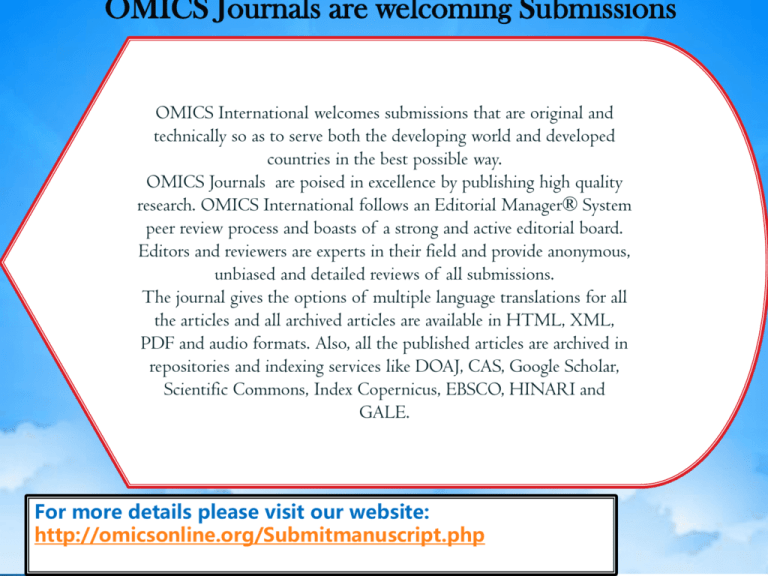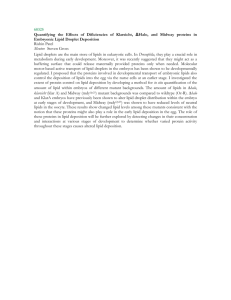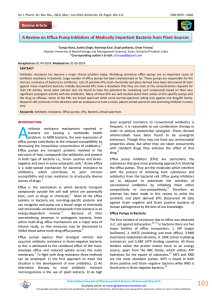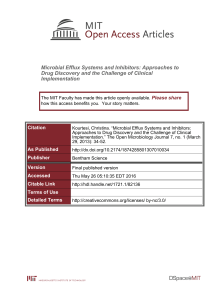Lipid Based Oral Drug Delivery System (LBODDS)
advertisement

OMICS Journals are welcoming Submissions OMICS International welcomes submissions that are original and technically so as to serve both the developing world and developed countries in the best possible way. OMICS Journals are poised in excellence by publishing high quality research. OMICS International follows an Editorial Manager® System peer review process and boasts of a strong and active editorial board. Editors and reviewers are experts in their field and provide anonymous, unbiased and detailed reviews of all submissions. The journal gives the options of multiple language translations for all the articles and all archived articles are available in HTML, XML, PDF and audio formats. Also, all the published articles are archived in repositories and indexing services like DOAJ, CAS, Google Scholar, Scientific Commons, Index Copernicus, EBSCO, HINARI and GALE. For more details please visit our website: http://omicsonline.org/Submitmanuscript.php An emerging platform for oral delivery of drugs with poor aqueous solubility Utilization of lipid as a carrier for the delivery of poorly water soluble, lipophilic drugs BA enhancement & normalization Targeted lymphatic delivery Low Solubility High First-Pass Metabolism High Efflux Transportation Low Dissolution Low Permeability High Preabsorptive Metabolism Active uptake transporters: FATP4/SRB1 Efflux transporters: Pgp/BCRP/MRP A BIG NO (X) Long been practiced Vegetable dressings with olive oil, cheese or mayonnaise Enhance absorption of water-insoluble vitamins/nutrients Eg.: Fat-soluble vitamins, carotenoids like beta-carotene, lutein, etc. Country Product % No. of Products UK 2% 21 US 3% 27 Japan 4% 8 Physicochemical diversity Biocompatibility Ability to enhance oral BA through lymphatic delivery Complex physicochemical properties Challenges in stability & manufacturing Limited solubility of some poorly watersoluble drugs in lipids Pre-absorptive gastrointestinal processing Lack of knowledge about the in vivo behavior and influence of co-administered drugs/lipids Lack of predictive in vitro and in vivo testing methodologies In-depth knowledge of the GI digestive process of lipid Ability to interpret biopharmaceutical properties of lipid formulations Designing knowledge of relevant in vitro tests to mimic the physiological environment for the lipid formulation Biorelevant dissolution media In vivo colloidal behavior of the LBODDS Lipids Simple Lipids (Esters of FA + Alcohol) Fats (FA + Glycerol) Solid (Fats) Waxes (FA + Alcohol) Liquid (Oils) Compound Lipids Derived Lipids Associated Substatnces 1 Phospholipids 1 FA 1 Carotenoids 2 Glycolipids 2 Glycerides 2 Tocopherols 3 Sulpholipids 3 Alcohols 3 Fat sol. vitamins 4 Lipoproteins 4 Bases 4 Steroids Digestive Phase Absorption Phase Circulatory Phase Autocatalytic Process Carrier Process Size-selective Process 1. Physical breakdown 1. Entry drugs into 1. Lipophilic of lipids into coarse with logP > 5 with enterocyte by emulsion TG solubility > 50 passive diffusion, 2. Hydrolysis of TGs mg/ml enters facilitated diffusion into FAs and MGs lymphatic delivery and active 3. Mixed-micelle 2. Chylomicrons are transport formation with bile 2. Formation of TG & big in size and salts and/or vesicle access lymphatic PL from absorbed formation of FAs + transport FA & MG TGs 3. Formation of 3. FFA < 12 carbon absorbed by portal chylomicron and and more than that storage in golgi by lymph apparatus 4. Exocytosis into extracellular phase Drains Blood from spleen, pancreas & digestive organs HCO3 – neutral environment – max. lipase/colipase activity 2. More FA stimulates cholecystokinin into portal circ. 3. This stimulates pancreas to release more TG lipase/colipase FA & MG – partially ionized – potent emulsifier – promote binding of co-lipase-lipase complex to emulsion surface 1. Antral contraction shear 2. Retropropulsion 3. Gastric emptying 1. Key Points to Ponder SECRETI N Secretion of bile from gall bladder Bile Salt, Phospholipid, Cholesterol, HCO3Pancrease secretes Phospholipase Micelle/Mixed micelle/vesicle formation with bile salts and phospholipids Solubilization of precipitated/released drugs For digesion of lipids: bile acid, phospholipid, enzyme (lipase/colipase/phospholipase) , and HCO3are important Long chain FA (~2 g) stimulate gall bladder contraction and elevate intestinal biliary lipid accumulation compared to MCTs In vivo solubilization capacity depends on both lipophilicity and chemical structure of the drug and nature of endo/exogeneous lipids. Enzymatic action is interfacial process and the lipolysis is enhanced in formulations with good dispersability like SNEDDS/SMEDDS SNEDDS/SMEDDS maximize rate of drug partitioning into the aqueous intestinal fluids and provide consistent BA. Chylomicr on Exocytosis Chylomicr on Storage Chylomicr on Formation SCT /M CT Lymph delivery is size-selective transport LCT is necessary for stimulation of lipoprotein formation and lymphatic pathway Free FA chain length & composition and size of the lymph lipid precursor pool in the enterocyte play important role FFA <12 carbon absorbed by portal and more than that by lymph High unsaturated chain length produce larger size lipoprotein and enhance lymph delivery Lymph fluid with fats drains into left subclavian vein through thoracic duct and thus bypass first pass metabolism Micelles/mixed micelles become monomers in the blood due to large volume dilution, but chylomicrons stay Critical step TG Sol. >50 mg /ml No Effect Decreases Increases Decreases? No Effect: (No action) 1. Passive diffusion thro’ membrane 2. Saturate cellular transporter (efllux/absorptive) 3. Minimal transporter drug interaction Decreased: (inhibition) 1. Inhibition of uptake transporters (these drugs need this transporter for permeability due to poor permeability) Increased: (Dual action) 1. Passive diffusion thro’ membrane 2. Enhanced solubility 3. Saturation of efflux transporter by enhanced solubility Decreased?: (inhibition) 1. Inhibition of uptake transporters (these drugs need this transporter for permeability due to poor permeability) Minimize gut wall efflux Reduce enzymatic degradation No change in BA Minimize gut wall efflux Reduce enzymatic degradation Increase solubilization Enhance BA High metabolism Minimize gut wall efflux Reduce enzymatic degradation Enhance BA Minimize gut wall efflux Reduce enzymatic degradation Increase solubilization Enhance BA Clinical Pharmacology & Biopharmaceutics Related Journals Clinical & Experimental Pharmacology Pharmaceutical Care & Health Systems Journal of Developing Drugs http://www.pharmaceuticalconferences.com/ OMICS International Open Access Membership Open Access Membership with OMICS International enables academic and research institutions, funders and corporations to actively encourage open access in scholarly communication and the dissemination of research published by their authors. For more details and benefits, click on the link below: http://omicsonline.org/membership.php








